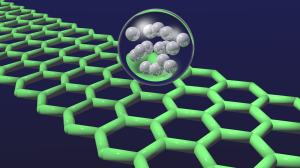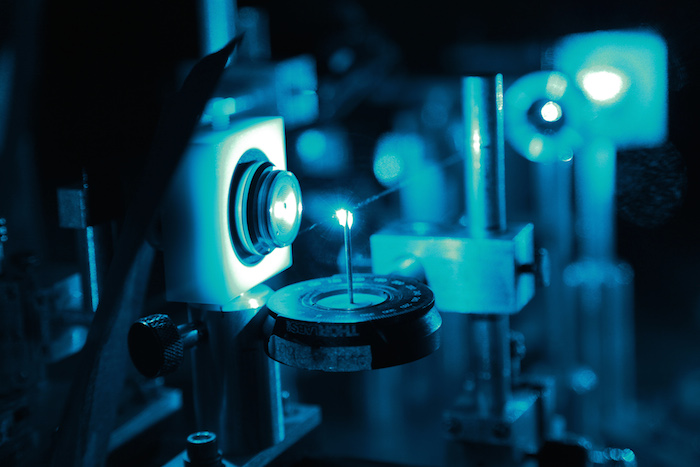Graphene
The Wonder Material Every Investor Should Get to KnowFor those interested in a material that’s turning the heads of both scientists and investors, we thought we’d give you a closer look at graphene and its capabilities. This perpetually reinvented “wonder material” has over 25,000 patent applications worldwide, an impressive feat considering it was only discovered just over 15 years ago. Graphene came into existence in 2003, when a physicist by the name of Andre Geim produced a material thinner than paper, stronger than diamond, and able to carry a thousand times more electricity than copper.
 Geim and his team were able to isolate this material using scotch tape to separate a single layer from a block of graphite, which resulted in a single atom, lattice-like structure, and the smallest portion of graphite ever created. You can learn more about the physics of Geim’s discovery in this detailed article from APS Physics.
Geim and his team were able to isolate this material using scotch tape to separate a single layer from a block of graphite, which resulted in a single atom, lattice-like structure, and the smallest portion of graphite ever created. You can learn more about the physics of Geim’s discovery in this detailed article from APS Physics.
The paper that Geim published post-discovery, entitled “Electric field effect in atomically thin carbon films” is one of the most well-cited papers in material physics, and for good reason: Graphene has since been used and applied in a variety of ways, and is frequently compared to plastic due to its potential and seemingly limitless versatility. The lack of vacancies and dislocations in the material structure of graphene make it one of the strongest materials discovered to date, at only a fraction of the weight of its “competitors.”
For example, when added to copper and nickel, graphene strengthened them by 180 and 500 times respectively, with only .00004% graphene in the resulting compound material for each. This is promising for lighter and tougher sports equipment—graphene is already being used in tennis racquets, shoes, and a variety of sportswear—as well as flexible electronics and increasingly strong materials for construction. It’s even being researched for its effectiveness in spinal cord injury treatment, prosthetics and implants, as well as other medical applications.
Graphene’s impressive conductivity also makes it an obvious material for creating stronger batteries, except for the fact that it has such a small surface area due to its essentially 2D nature. Researchers at Manchester Metropolitan University are currently looking into solving this surface area problem with 3D printing, which would increase the surface area and allow them to create batteries and super-capacitors that could be used to power phones and tablets, or as energy storage systems for solar, wind, and wave energy.
Researchers at Virginia Tech University and the Lawrence Livermore National Laboratory (LLNL) found a way to create 3D graphene aerogels and foams with 3D printers, contributing to the surface area challenges that face graphene. According to assistant professor Xiaoyu “Rayne” Zheng with the Department of Mechanical Engineering at Virginia Tech, “This opens up freedom to realize 3D graphene with any topology, co-optimized mechanical properties, hierarchical pore sizes, surface areas, and conductivities for a host array of applications.” 3D printing leads to even more potential applications, beyond graphene’s already impressive problem-solving capabilities.
 When compared to silicon, graphene proved to have a mobility (the speed at which an electrical charge flows across a semiconductor) that is 250 times that of silicon. With these traits, graphene could solve the problem of finding a replacement to silicon in technology like computer chips. Graphene is believed to potentially give CPUs the ability to run 1,000 times faster than silicon allows, and would use less power. But again, this is only the tip of the iceberg.
When compared to silicon, graphene proved to have a mobility (the speed at which an electrical charge flows across a semiconductor) that is 250 times that of silicon. With these traits, graphene could solve the problem of finding a replacement to silicon in technology like computer chips. Graphene is believed to potentially give CPUs the ability to run 1,000 times faster than silicon allows, and would use less power. But again, this is only the tip of the iceberg.
Graphene also has incredible heat withstanding capabilities, which is promising for the future of many of the electronics we use daily, such as phones and tablets. Graphene, when produced in a 3D form called ”white graphene,” creates a configuration in which heat photons move in multiple directions. With white graphene, electrical engineers have the opportunity to move heat through and away from key components in electronics, which means significant cooling opportunities for the devices we use everyday.
As graphene’s uses increase, so does the ease of its production. Researchers have been diligently attempting to find a way to mass produce graphene, and MIT engineers have recently discovered a viably scalable method for creating high-quality graphene membranes. They used a machine that combined the chemical vapor deposition process, which is how scientists typically synthesize graphene, with manufacturing roll-to-roll methods. They successfully produced graphene foil at a rate of 5cm per minute. Continuous running of the machine and on a larger scale could mean the beginning of mass production for graphene.
With each exciting new development in graphene research, the future of the wonder material looks brighter than ever. Graphene is strong, light and plentiful. Graphene has potentially limitless potential for innovating and powering our future technology, from electronics to energy to the supercars and bulletproof armor of tomorrow. This wonder material has so many applications to improve society at large that it’s an essential investment choice for any savvy investor.
